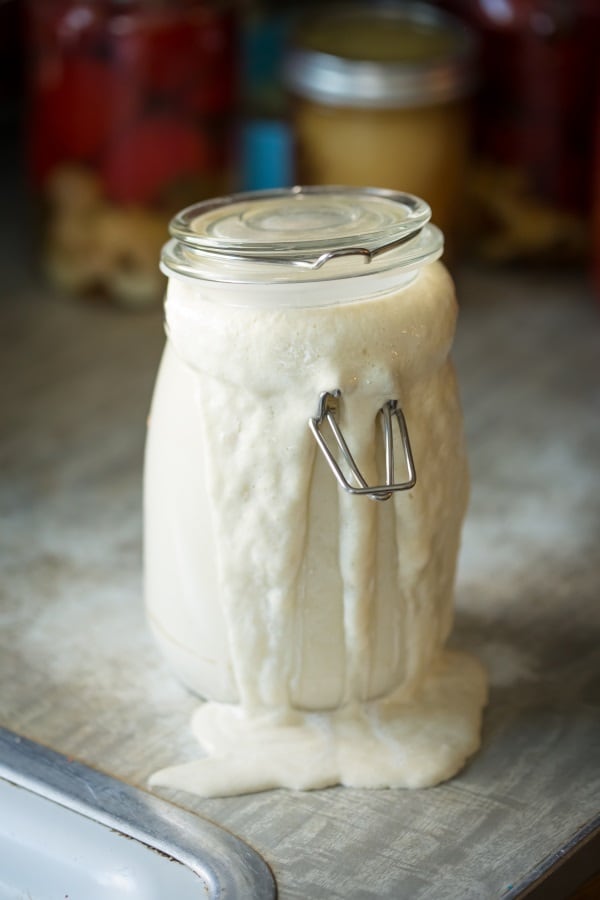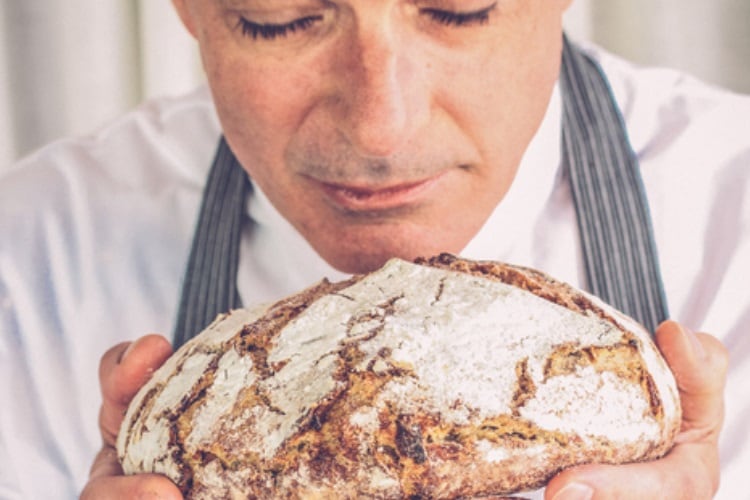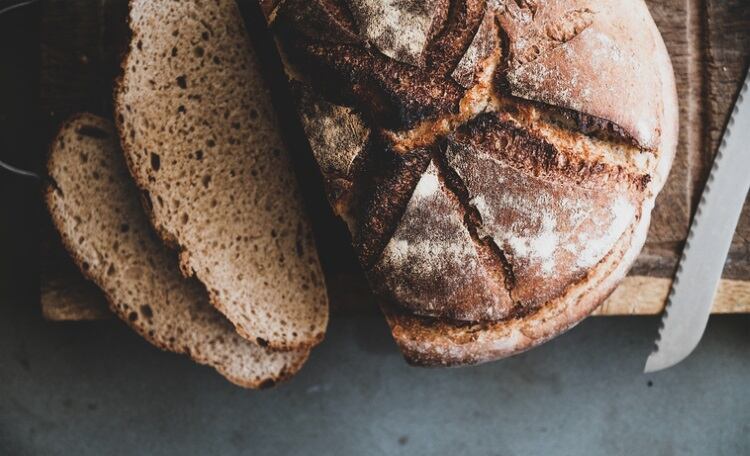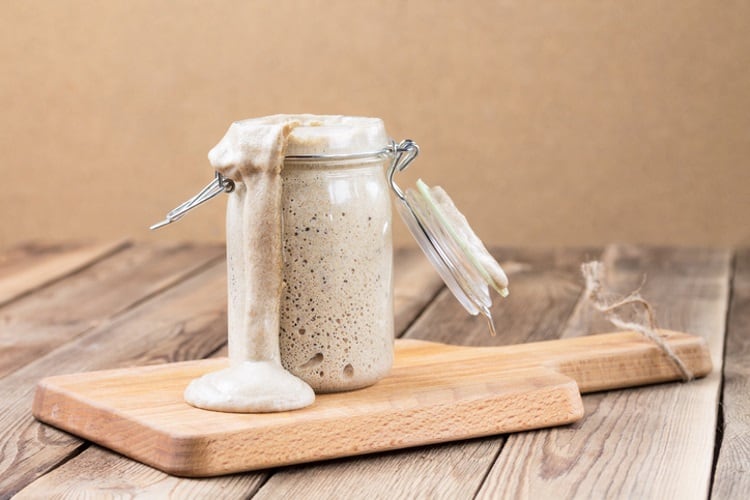Flavour recombination experiments revealed sodium, potassium, ammonium, chloride, magnesium, calcium, d-fructose, l-glutamic acid, acetic acid and lactic acid as the key taste compounds. Key aroma compounds were identified as acetic acid, butyric acid, vanillin, 3-methylbutyric acid, hexanal, 2,3-butanedione, phenylacetaldehyde, 3-methylbutanal, methional, (E,E)-decadienal and (E)-2-nonenal.
Recombination is a process used to create genetic diversity, so the DNA sequences of different organisms can be identified.
Whew, that’s a mouthful, so let’s break it down.
Sourdough is noted for its unique flavour, the key characteristic being its distinctive sourness. However, it’s still not clear which metabolites significantly contribute to the authentic taste of sourdough bread crumb.
Whereas the flavour of the bread crust is predominantly formed by thermal reactions during the baking process, the flavour of the bread crumb is essentially developed by enzymatic reactions during the dough fermentation by lactic acid bacteria and yeasts. The crumb flavour is also influenced by factors like flour type, starter culture, fermentation time and temperature
The researchers from the Professorship for Food Chemistry and Molecular Sensory Science at the TUM School of Life Sciences, Technical University of Munich, set out to identify and quantify the key taste and aroma compounds in sourdough bread crumb - to reveal their sensory impact and to verify their taste contribution.
As the aroma compounds in rye bread crumb are already known - a 2001 study identified 20 odorants, including the cornucopia listed above - the objective was to simplify the basket by means of omission and combination experiments to reveal the key odorants.
Furthermore, it was the aim to develop and validate a LC-MS/MS method (a rapid and cost-effective measurement of organic molecules) to quantify both key tastants and odorants of sourdough bread crumb.
The scientists believe this approach will be helpful for controlling the flavour quality independent of time-consuming sensory analyses during the industrial production of breads.
“We hope our findings and the quantification method we developed will help bakers achieve consistent quality in their sourdoughs,” said Laura Eckrich, a graduate student of Thomas Hofmann’s team at the Technical University of Munich.
“For example, they can prevent the bread from becoming too sour.”
Breaking down sourdough

Authentic sourdough is naturally leavened bread, made from nothing more than flour, water, salt and a ‘starter’ - a fermented flour and water mix that contains wild yeast and good bacteria – in place of a commercial yeast to rise. Wild yeast has more flavour than commercial yeast, producing sourdough’s distinctive tangy flavour and slightly chewy texture.
A standard sourdough is made using a strong white bread flour, however, many other flours - or combination of flours - can be used to create differentiation. For example, 3:1 bread flour to wholemeal, granary, seeded or malted flour; or 4:1 bread flour to rye, spelt, emmer, buckwheat or Khorasan flour. The baker must bear in mind that some flours are ‘thirstier’ than others.
The ‘mother’ starter is made from white bread flour and water but needs ‘feeding’ for four to five days to activate the lactic acid bacteria and wild yeast living in the flour and surrounding environment. The yeasts cause the dough to rise by creating carbon dioxide bubbles, while the lactic acid bacteria provide the sour flavour - in the form of acetic acid and lactic acid - and preserve the bread by lowering its pH, which prevents the growth of food borne pathogens.
The sensory approach

Using both yeast-based and sourdough breads, obtained from local bakeries and supermarkets made with either rye or wheat flour, the scientists employed the Sensomics approach to decode the so-called sensometabolome (the complete composition of key sensory-active, low molecular weight compounds that trigger the perception of taste and smell).
“This was the first time the key taste and aroma compounds of bread crumb were elucidated using the sensomics approach,” said Eckrich.
“With sensomics, you can take just a few key compounds and completely recreate the characteristic taste of a food.”
The approach involves chromatography, mass spectrometry and similar methods to determine their structures and concentrations and how they contribute to taste.
A sensory panel composed of 17 skilled human tasters (aged 23-32 years) was also enlisted to analyse the flavour essences.
All sessions were performed in single booths of an air-conditioned sensory room and the light adjusted to orange to mask visual differences between the samples. Between each sample, the panellists were required to rinse their mouths with water for the taste tests or neutralised their odour perception by smelling roasted coffee beans. For the taste evaluation, the panellists used nose clips to prevent cross-modal (between the different senses) interaction with the aroma compounds.
To become familiar with the taste language and impressions, the panellists were trained to identify and assess various reference solutions targeting salty, sour, sweet, bitter, astringent and umami tastes, along with kokumi activity (mouthfulness enhancement). Similar training was conducted to recognise the different qualities of different odorants (sour, malty, buttery, spicy, sweaty, fatty, caramel-like, roasty and coffee-like).
Key tastants

In addition to the distinct tastes of lactic acid and acetic acid, the scientists pinpointed sodium chloride, added to the bread as table salt. As bread can make up a sizable amount of the daily salt intake, the scientists also identified broad potential for lowering the salt concentration in bread without sacrificing its distinctive flavour.
A 2023 survey by Action on Salt found three in four brands of prepacked sliced breads contain at least as much salt per slice as a packet of ready salted crisps. Sourdough had the highest average salt content (0.96g/100g) compared to the lowest: seeded bread (0.86g/100g).
The remaining minerals originated from other ingredients, namely flour and water. Potassium content was in line with levels of other breads (wheat, rye, mixed wheat), while ammonium, phosphate, magnesium and calcium were present in much lower concentrations and had a minor effect on the overall taste of sourdough bread crumb.
Ferulic acid (derived from grain flour) was found in the same concentrations as in wheat and rye bread, while ethanol (produced by the wild yeast and lactobacillus bacteria) was aligned to that found in the crumb of French baguettes and ciabatta bread.
While fructose, glucose, maltose and sucrose play a role in ‘feeding’ the sourdough fermentation, acetic acid, lactic acid, ethanol, glycerol and succinic acid (slightly sour flavour) are produced during fermentation.
Distinguished odorants

The task to identify the key odorants started with the 20 odorants found in the 2001 study. However, the sensory panel found many showed no significant differences, so the study whittled the list down to 11 key components: acetic acid (sour), butyric acid (sweaty), vanillin (sweet), 3-methylbutyric acid (cheesy), hexanal (fruity), 2,3-butanedione (buttery), phenylacetaldehyde (honey-like), 3-methylbutanal (malty), methional, (E,E)-decadienal (citrus) and (E)-2-nonenal (greasy, grassy).
Acetic acid essentially affects both the taste and the aroma of sourdough bread crumb.
In conclusion, 10 main flavours and 11 important fragrance odorants were found to replicate the distinctive characteristic of sourdough breadcrumb.
“For the first time, the present method enables a unified high-throughput quantitation of the volatile key odorants and the nonvolatile key tastants of sourdough bread crumb with the same instrumental setup,” wrote the study’s authors.
“This method can be used to create a blueprint of the valuable aroma and taste compounds of breads to be independent of sensory tests in the future - especially during the industrial production of breads - and to obtain objective statements on the aroma and taste quality of breads.”
This research was funded by the Deutsche Forschungsgemeinschaft (German Research Foundation).
Studies:
The sensory-directed elucidation of the key tastants and odorants in sourdough bread crumb
Authors: Laura Sophie Amann, Oliver Frank, Corinna Dawid and Thomas Frank Hofmann
Foods 2022, 11(15), 2325
doi.org/10.3390/foods11152325
Authors: E Kirchhoff and P Schieberle
J. Agric. Food Chem. 2001, 49, 4304-4311
doi.org/10.1021/jf010376b





